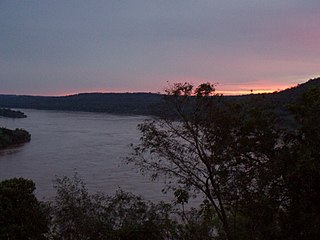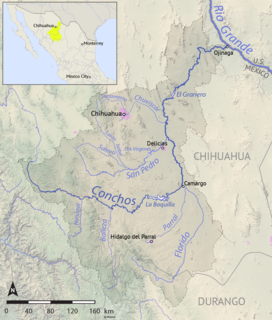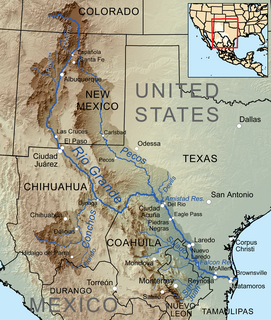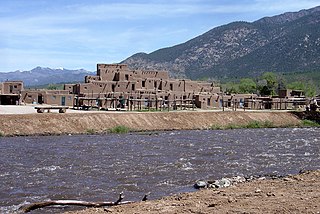| Escondido River | |
|---|---|
| Country | Mexico |
| State | Coahuila |
| Physical characteristics | |
| Source | Serranias del Burro |
| - coordinates | 28°41′58″N101°31′2″W / 28.69944°N 101.51722°W [1] |
| - elevation | 1,000 m (3,300 ft) [1] |
| River mouth | Rio Grande |
| - location | Piedras Negras |
| - coordinates | 28°39′43″N100°30′2″W / 28.66194°N 100.50056°W Coordinates: 28°39′43″N100°30′2″W / 28.66194°N 100.50056°W [2] |
| - elevation | 200 m (660 ft) [1] |
| Length | 150 km (93 mi) [1] |
| Discharge | |
| - location | IBWC station 08-4581.50 at Villa de Fuente, Coahuila [3] |
| - minimum | 0 m3/s (0 cu ft/s) |
| - average | 1.64 m3/s (58 cu ft/s) [3] |
| - maximum | 883 m3/s (31,200 cu ft/s) |
| Basin features | |
| Basin size | 3,810 km2 (1,470 sq mi) [3] |
The Escondido River (Río Escondido in Spanish, sometimes called Arroyo Río Escondido [4] ) is a stream in the state of Coahuila, Mexico, and is a tributary of the Rio Grande.

Coahuila, formally Coahuila de Zaragoza, officially the Free and Sovereign State of Coahuila de Zaragoza, is one of the 31 states which, along with Mexico City, compose the 32 Federal Entities of Mexico.

Mexico, officially the United Mexican States, is a country in the southern portion of North America. It is bordered to the north by the United States; to the south and west by the Pacific Ocean; to the southeast by Guatemala, Belize, and the Caribbean Sea; and to the east by the Gulf of Mexico. Covering almost 2,000,000 square kilometres (770,000 sq mi), the nation is the fifth largest country in the Americas by total area and the 13th largest independent state in the world. With an estimated population of over 120 million people, the country is the eleventh most populous state and the most populous Spanish-speaking state in the world, while being the second most populous nation in Latin America after Brazil. Mexico is a federation comprising 31 states and Mexico City, a special federal entity that is also the capital city and its most populous city. Other metropolises in the state include Guadalajara, Monterrey, Puebla, Toluca, Tijuana and León.

The Rio Grande is one of the principal rivers in the southwest United States and northern Mexico. The Rio Grande begins in south-central Colorado in the United States and flows to the Gulf of Mexico. Along the way, it forms part of the Mexico–United States border. According to the International Boundary and Water Commission, its total length was 1,896 miles (3,051 km) in the late 1980s, though course shifts occasionally result in length changes. Depending on how it is measured, the Rio Grande is either the fourth- or fifth-longest river system in North America.
The Escondido enters the Rio Grande (Rio Bravo del Norte in Mexico) at Rio Grande river kilometer 794 kilometres (493 mi), about 5 kilometres (3.1 mi) downriver from Piedras Negras, Coahuila, and Eagle Pass, Texas. [3]

In the United States, a river mile is a measure of distance in miles along a river from its mouth. River mile numbers begin at zero and increase further upstream. The corresponding metric unit using kilometers is the river kilometer. They are analogous to vehicle roadway mile markers, except that river miles are rarely marked on the physical river; instead they are marked on navigation charts, and topographic maps. Riverfront properties are sometimes partially legally described by their river mile.

Piedras Negras is a city and seat of the surrounding municipality of the same name in the Mexican state of Coahuila. It stands at the northeastern edge of Coahuila on the U.S.-Mexico border, across the Rio Grande from Eagle Pass in the U.S. state of Texas. In the 2015 census the city had a population of 163,595 inhabitants, while the metropolitan area had a population of 245,155 inhabitants. The Piedras Negras and the Eagle Pass areas are connected by the Eagle Pass-Piedras Negras International Bridge, Camino Real International Bridge, and the Eagle Pass Union Pacific International Railroad Bridge.

Eagle Pass is a city in and the county seat of Maverick County in the U.S. state of Texas. The population was 26,255 as of the 2010 census.
The Escondido originates in the Serranias del Burro mountain range and flows generally east to the Rio Grande. Its main tributary is the Rio San Antonio, which enters the Escondido about 19 kilometres (12 mi) upriver from the Rio Grande confluence. [3]










